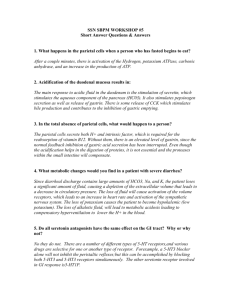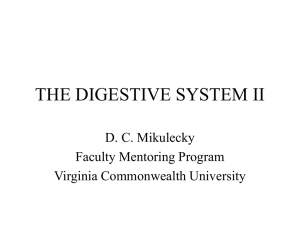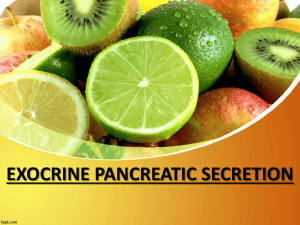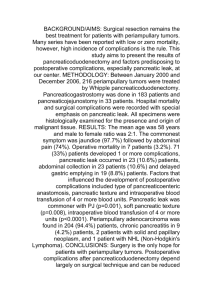PANCREATIC SECRETION
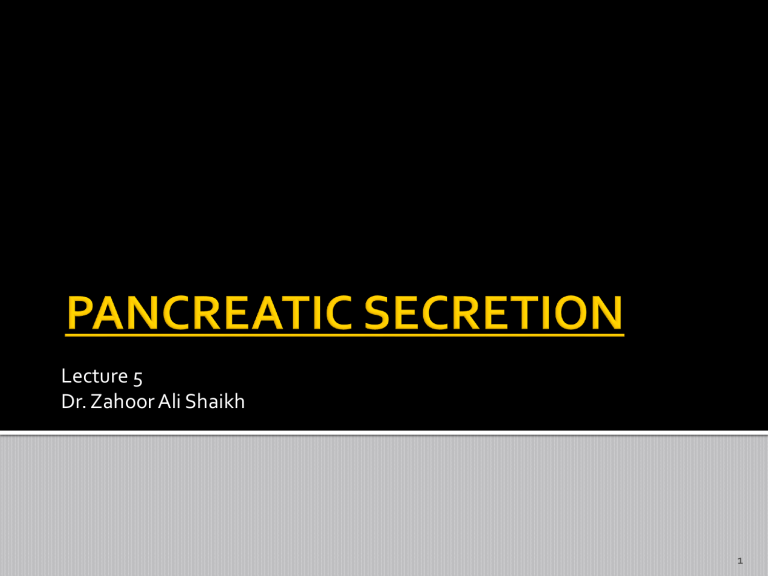
Lecture 5
Dr. Zahoor Ali Shaikh
1
When food comes to small intestine
[duodenum], it is mixed with pancreatic secretion and bile [pancreas and liver are accessory digestive organs].
PANCREAS
It is exocrine and endocrine secretion.
We will discuss exocrine secretion.
2
Pancreas is elongated gland lies behind and below the stomach.
Pancreas has Acini and ducts.
- Pancreatic Acinar cells secrete – digestive enzyme.
- Pancreatic duct – secrete watery secretion rich in NaHCO
3
3
Pancreatic secretion per day is 1 – 2 liters.
pH – approximately 8.0
It has
- Water
- Cations – Na, K, Ca, Mg
- Anions – HCO
3
, Cl, SO
4
, HPO
4
- Digestive enzymes
4
5
Exocrine Pancreas secretes pancreatic juice.
It has two components:
1. Pancreatic enzymes – secreted by Acinar cells.
2. Watery [aqueous] alkaline fluid rich in
NaHCO3 actively secreted by duct cells that line the pancreatic ducts.
6
1. Pancreatic enzymes
The pancreatic enzymes are stored in zymogen granules after they are produced.
They are released by exocytosis as needed.
Pancreatic enzymes are important because they can completely digest food, in absence of all other digestive secretions.
7
Pancreas Acinar cell secrete three types of pancreatic enzymes:
(i). Proteolytic enzymes for protein digestion.
(ii). Pancreatic amylase for carbohydrate digestion.
(iii). Pancreatic Lipase for fat digestion.
We will discuss one by one.
8
(i). Pancreatic Proteolytic enzymes
Major Proteolytic enzymes are
- Trypsinogen
- Chymotrypsinogen
- Procarboxypeptidase
They are secreted in INACTIVE form.
9
How these Proteolytic enzymes are activated?
When Trypsinogen is secreted into the duodenal lumen, it is activated to its active form TRYPSIN by Enterokinase
[enteropeptidase], an enzyme which is embedded in the mucus membrane of duodenal mucosa.
10
Trypsin once formed activates Trypsinogen
[autocatalytic] and also Chymotrypsinogen and Procarboxypeptidase.
They are converted to active form by Trypsin in duodenal lumen also.
IMPORTANT – We need initially Enterokinase to form trypsin. Once trypsin is formed it carries out other processes.
11
12
Proteolytic Enzymes [Trypsin, Chymotrypsin,
Carboxypeptidase] attack different peptide linkages.
End result is formation of small peptide chains and amino acids.
13
Pancreatic amylase causes conversion of polysaccharides into disaccharide maltose.
Pancreatic amylase is secreted in the Active form as it is not the risk for auto digestion of pancreas.
14
Pancreatic lipase is very important. Why?
Because it is the only enzyme secreted throughout the digestive system that can digest fat.
NOTE – In human, insignificant amount of lipase are secreted in the saliva and Gastric
Juice called Lingual Lipase and Gastric Lipase.
15
Pancreatic lipase hydrolysis dietary triglycerides into Monoglyceride and Free fatty acids, which are absorbed in small intestine.
Pancreatic lipase is secreted in Active form as it is not the risk for pancreatic auto-digestion.
16
Pancreatic insufficiency
When pancreatic enzymes are deficient, digestion of food is incomplete.
As pancreatic lipase is the only significant source for fat digestion, its deficiency results in Maldigestion of fats, it is called
STEATORRHEA [increased undigested fat in feces].
17
Up to 60 – 70% of fat taken maybe excreted in feces in STEATORRHEA.
Digestion of protein and carbohydrate is impaired to a lesser degree because salivary, gastric and small intestine enzymes contribute to their digestion.
18
As highly acidic Gastric contents are emptied into the duodenal lumen, this acidic Chyme must be neutralized quickly in the duodenal lumen. Why?
- Because to allow the functioning of pancreatic enzymes [they work in neutral or slightly alkaline medium]. NaHco
3 in pancreatic fluid neutralizes the acidic Chyme.
- To prevent damage to duodenal mucosa.
19
It is hormonal and neural mechanism.
1. Mainly by hormonal mechanism – secretin and Cholecystokinin [CCK].
2. Parasympathetic stimulation – little contribution during cephalic phase.
20
When Chyme enters the duodenum, Two major hormones secretin and CCK
[Entrogastrones] are released in response to
Chyme.
21
22
We will discuss role of secretin and CCK.
SECRETIN
Primary stimulus for secretion of secretin is acid in the duodenum.
Secretin is carried by blood to the pancreas where it stimulates the duct cells to increase
NaHCO
3 rich watery secretion in the duodenum.
NaHCO
3 neutralizes the acid content of
Chyme.
23
CHOLECYSTOKININ [CCK]
CCK is released from duodenal mucosa.
Main stimulus for release of CCK is Fat, to a lesser extent protein.
CCK is transported by blood to pancreas
Acinar cell to increase digestive enzyme secretion.
24
CHOLECYSTOKININ [CCK] (cont)
These pancreatic enzymes help to digest fat, protein and carbohydrate.
All three types of enzymes [for protein, fat, and carbohydrate] are packed in Zymogen granules together, therefore, all are released together by exocytosis.
25
Pancreatic Exocrine Secretion
Composition
Pancreatic Enzymes & Their Importance
Steatorrhea
Mechanism of Pancreatic Juice Secretion
Regulation of Pancreatic Exocrine Secretion -
Hormonal & Neural
26
27
